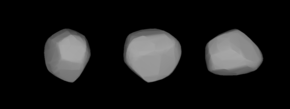
281 Lucretia

 A three-dimensional model of 281 Lucretia based on its light curve | |
| Discovery | |
|---|---|
| Discovered by | Johann Palisa |
| Discovery date | 31 October 1888 |
| Designations | |
| (281) Lucretia | |
| Pronunciation | /luːˈkriːʃə/ |
Named after | Caroline Lucretia Herschel |
| A888 UC, 1906 FD 1948 EK, 1984 JX | |
| Main belt (Flora family) | |
| Orbital characteristics [1] | |
| Epoch 31 July 2016 (JD 2457600.5) | |
| Uncertainty parameter 0 | |
| Observation arc | 126.00 yr (46020 d) |
| Aphelion | 2.47750 AU (370.629 Gm) |
| Perihelion | 1.89821 AU (283.968 Gm) |
| 2.18786 AU (327.299 Gm) | |
| Eccentricity | 0.13239 |
| 3.24 yr (1182.0 d) | |
| 161.880° | |
| 0° 18m 16.423s / day | |
| Inclination | 5.30407° |
| 31.4134° | |
| 16.7540° | |
| Physical characteristics | |
| Dimensions | 11.76±0.9 km [1] 12 km [2] |
Mean density | ~2.7 g/cm3[3] |
| 0.181 d (4.348 h)[4] | |
| 0.1987±0.035 [1] 0.199 [2] | |
| S [5] | |
| 12.02 | |
281 Lucretia is an asteroid belonging to the Flora family in the Main Belt.[4] It was discovered by Austrian astronomer Johann Palisa on 31 October 1888 in Vienna, and is named after the middle name of Caroline Herschel, one of the first female astronomers.[6] Light curves of this asteroid show a synodic rotation period of 4.349±0.001 h with an amplitude of 0.3–0.4 magnitude. The spin axis appears nearly perpendicular to the ecliptic.[4]

References
- ^ a b c "281 Lucretia". JPL Small-Body Database. NASA/Jet Propulsion Laboratory. Retrieved 11 May 2016.
- ^ a b Supplemental IRAS Minor Planet Survey Archived June 23, 2006, at archive.today
- ^ Krasinsky, G. A.; et al. (2002). "Hidden Mass in the Asteroid Belt". Icarus. 158 (1): 98–105. Bibcode:2002Icar..158...98K. doi:10.1006/icar.2002.6837.
- ^ a b c Kryszczynska, A.; et al. (October 2012). "Do Slivan states exist in the Flora family?. I. Photometric survey of the Flora region". Astronomy & Astrophysics. 546: 51. Bibcode:2012A&A...546A..72K. doi:10.1051/0004-6361/201219199. A72.
- ^ "Asteroid Taxonomy". Planetary Science Institute. Retrieved 27 February 2016.
- ^ Schmadel, Lutz D. (2007). "(281) Lucretia". Dictionary of Minor Planet Names – (281) Lucretia. Springer Berlin Heidelberg. p. 38. doi:10.1007/978-3-540-29925-7_282. ISBN 978-3-540-00238-3.
External links
- 281 Lucretia at AstDyS-2, Asteroids—Dynamic Site
- 281 Lucretia at the JPL Small-Body Database

See what we do next...
OR
By submitting your email or phone number, you're giving mschf permission to send you email and/or recurring marketing texts. Data rates may apply. Text stop to cancel, help for help.
Success: You're subscribed now !
